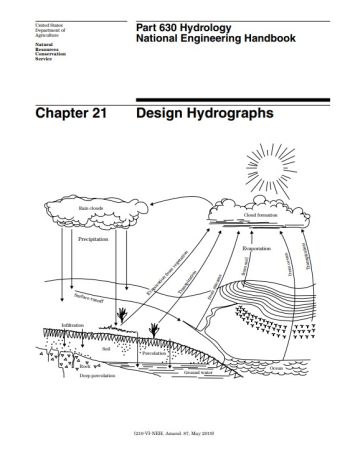National Engineering Handbook: Chapter 21 - Design Hydrographs
Natural Resources Conservation Service, 2019

Chapter 21 (NEH630.21) presents a systematic approach to the development of hydrographs used to design earth dams that provide temporary storage for flood prevention and temporary or permanent storage for other uses. NEH630.21 is a companion document to Technical Release No. 60 (TR–60), Earth Dams and Reservoirs, which contains the NRCS minimum design criteria for earth dams. While NEH630.21 and TR–60 are very closely related, it is important that users understand TR–60 contains the design requirements while NEH630.21 describes technical methods for developing design hydrographs.
While the methodologies are based on data of actual storms and floods, they are not intended for reproducing hydrographs of historical floods. The general methodology for the development of flood hydrographs is found in NEH630.16.
Also included in NEH630.21 are methods for modifying design runoff to include effects of baseflow, channel losses, quick return flow (QRF) upstream releases, and methods for developing rainfall distributions associated with design hydrograph development. The SITES computer program may be used to develop design hydrographs for a particular project.
An earth dam generally has two spillways, a principal spillway and an auxiliary spillway, and perhaps a low flow outlet to meet downstream and instream needs. The design of a safe dam requires that the spillways be sized appropriately. This is done by routing several hydrographs through the spillways. Development of these design hydrographs takes into account storm return period and duration, which varies depending upon purpose, size, location and classification of the dam and types of spillways.
Revision ID: 5873
Revision Date: 12/16/2022
